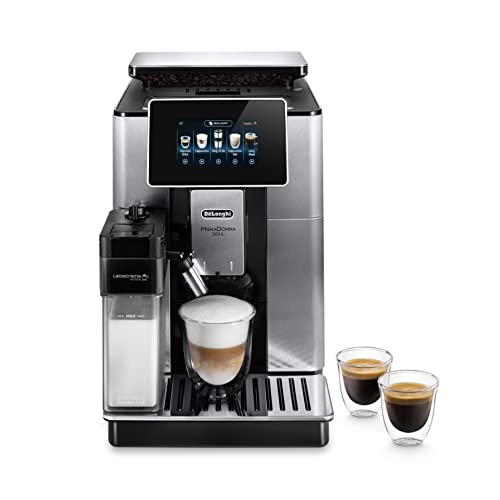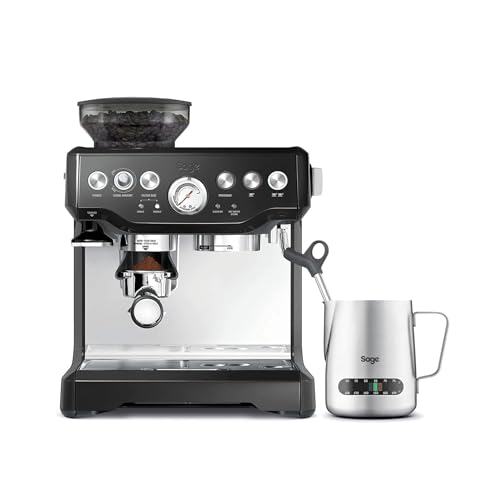포토센서 11 "Faux Pas" That Are Actually OK To Create With Your Bean …
페이지 정보

본문
 Coffee bean to coffee machine Coffee Machines
Coffee bean to coffee machine Coffee MachinesIf you purchase a coffee bean machine, you can enjoy fresh, delicious whole-bean coffee that is made according to your specific requirements. The machine grinds, measures, tamps, and forces hot water into the grounds to create delicious, flavorful coffee.
These machines have several advantages over pod machines, including reduced environmental waste and user-friendly. The machine is fully automated and can be operated by pressing a button.
Here are a few alternatives to the word "grind"
The kind of grind you choose is vital to making a great cup of coffee. The size, form and consistency are all important. If beans are not properly crushed, it can cause the water to flow too fast through the grind, leading to under extraction of flavor or excessive extraction of bitterness.
A good grinder should have a variety of sizes of grind to allow you to choose the best method for your brew. It is essential to test different grind sizes, as they can significantly alter the flavor of your beverage. The smaller sizes of grinds are ideal for espresso and French press, while the larger, more coarsely ground particles are ideal for immersion brewing such as the Chemex or coffee bean machine Moka pot.
If you want to get an even more gourmet cup of coffee, you can try roasting your own beans and grinding the beans prior to making the coffee. This will maximize the aroma and flavor of your brew and help create an excellent cup every time. It is also essential to store the ground beans in an airtight container in an environment that is cool and dark to preserve their freshness and flavor.
Bean to cup commercial coffee machines offer unbeatable convenience and allow you to enjoy barista-quality coffee with the click of an button. These machines handle everything from preparation of the beans, to tamping them, making them an ideal option for busy cafes and offices.
They start by grinding your choice of beans to a precise size. They can be set to match your preferred brew method and are able to be programmed to serve the desired amount of cups at once. Certain machines will automatically compact the grounds to ensure the most efficient extraction.
A machine that makes bean-to-cup usually has a large hopper for you to fill with beans. The machine will then automatically grind and disperse the right amount of beans to suit the brew method you select. These machines typically display to show you the size of the grind and the dose chosen along with the total number of drinks it's set to prepare.
Extraction
When the coffee is ground, it is broken into smaller pieces, referred to as particles. The size of the particles could have an impact on the extraction process as well as the final cup's flavor. In a bean to cup machine the particle size of the beans is controlled prior brewing so that it matches to the extraction method required by the machine. This allows you to get a great cup of coffee every time, and doesn't require the expertise of a barista.
The brew time in the bean-to-cup machine can be controlled to achieve exactly the amount you wish to drink. This can be a big advantage over pod machines, which often provide less control and can result in weaker or more bitter tasting coffee. Bean-to-cup machines let you control not only the brew time as well as the water temperature. This lets you decide how strong your coffee will be.
Extraction is an extremely delicate process that is dependent on the correct balance of particle size, dose and pressure. A poor extraction of coffee could be caused by any of these variables. Under-extracted coffee will taste sharp and sour and coffee that is over-extracted will taste bitter and dry.
In order to ensure that your coffee is extracted correctly, it's important to have a good quality grinder and use the correct beans. Light roasts are usually a bad choice for fully automated or espresso machines, since the short extraction process can result in a coffee that is with a lack of body and flatness. Darker roasts with a high Robusta percentage, like our Jhai (100% Robusta), or Tiga Terra are ideal for these machines due to the fact that they have more robust flavors and bodies.
The final decision between a bean-to-cup or pod coffee machines is a matter of your personal preference and the convenience. Pod coffee machines are great to make tea and coffee. However, they can be less efficient and produce waste when disposing of used pods.
Dispensing
If you use whole beans you can save money as well as have more flexibility. However this also means your machine will require more regular maintenance and cleaning than a pod-based model.
Fortunately they've been made with low maintenance in mind, and many have features that help with this. For instance, the majority of coffee makers with beans-to-cups have automatic cleaning cycles and rinsing which makes it simple to keep your machine clean and not disrupt your daily activities.
Another convenient feature is the possibility to add steaming hot milk to coffee drinks. This lets your team tailor their drinks to their tastes and preferences while boosting productivity. Additionally, it's an excellent way to demonstrate to your team that you care about their well-being. It has been scientifically proven that coffee may increase the production of dopamine as well as norepinephrine, which increases concentration and motivation at work.
Some models even offer customization options for beverages, such as texturizing the milk in cappuccinos and lattes. This feature is a key selling point for baristas, who may have only the time to prepare each cup of De'Longhi Dinamica Fully-Automatic Coffee Machine in Coffee Store.
The size of the water tank and the bean hopper are crucial aspects to look out for when selecting a top-quality bean-to cup coffee maker. The tank determines the length of time the machine will run before requiring a refill, while the size of the hopper determines how often you'll have to replenish your beans. Generally, the larger capacity of each one tank, the less often you'll need to restock.
You should carefully consider what type of beans you will be using before purchasing a bean to cup coffee maker. Different grind sizes can affect the taste and consistency of each cup. In addition, you must examine the machine's programmable settings that let users tweak aspects of their drinks to make the perfect drink every time.
The spouts for dispensing coffee from your coffee bean machine may be blocked by coffee residue or other particles left over after grinding. To avoid an inconsistent and slow flow that could lead to an insufficient amount of grounds of coffee, the spouts should be cleaned regularly. This can be caused by excessively coarse grinding settings or overly dry or oily beans or an absence of regular cleaning and rinsing.
Cleaning
Cleaning coffee machines is a vital part of maintaining one. It prevents the buildup and accumulation of residues, which can affect the taste and quality. Regular cleaning ensures that the machine is in good condition and decreases the chance of a breakdown which could result in costly repairs. Many bean-to cup coffee makers come with a built-in cleaning cycle which will flush through pipes to cleanse the brewing unit. Some will include separate milk side cleaning cycle to ensure that both spouts are clean and safe.
A good rental supplier will usually train their staff on the entire maintenance and cleaning process during installation. This will reduce any confusion about the process and ensure that each step is adhered to. Clear instructions and a thorough understanding of the procedure can help you avoid costly repairs or low-quality drinks.
After every use, it is recommended to clean your carafe and permanent filter with soapy water or in the dishwasher, in the event that the item is marked as safe. It is a good idea to run two or three times of clean water, without K cups or espresso ground in the machine. This helps to remove any oily residue and prevent the build up of yeast, bacteria, coffee bean machine or mould.
It is recommended for single-serve coffee machines or pod coffee makers to perform deep cleaning and descale every four weeks. A vinegar solution is normally employed for this. You can add up to 4 cups of vinegar in the reservoir and then run the machine for an brewing cycle. When the cycle is finished wash and descale according to the instructions of the manufacturer and run a couple of cycles of fresh water to remove any vinegar odor.
 Commercial machines have a built-in Telemetry system that records every cleaning cycle. You or your supplier can review this data to make sure that the machine is cleaned regularly. This could also alert you to any moving parts that have become stuck or stuck, which could require more thorough repair and maintenance work.
Commercial machines have a built-in Telemetry system that records every cleaning cycle. You or your supplier can review this data to make sure that the machine is cleaned regularly. This could also alert you to any moving parts that have become stuck or stuck, which could require more thorough repair and maintenance work.- 이전글Are Coffee Machine Espresso The Greatest Thing There Ever Was? 24.05.08
- 다음글Is Technology Making Medical Malpractice Legal Better Or Worse? 24.05.08
댓글목록
등록된 댓글이 없습니다.
